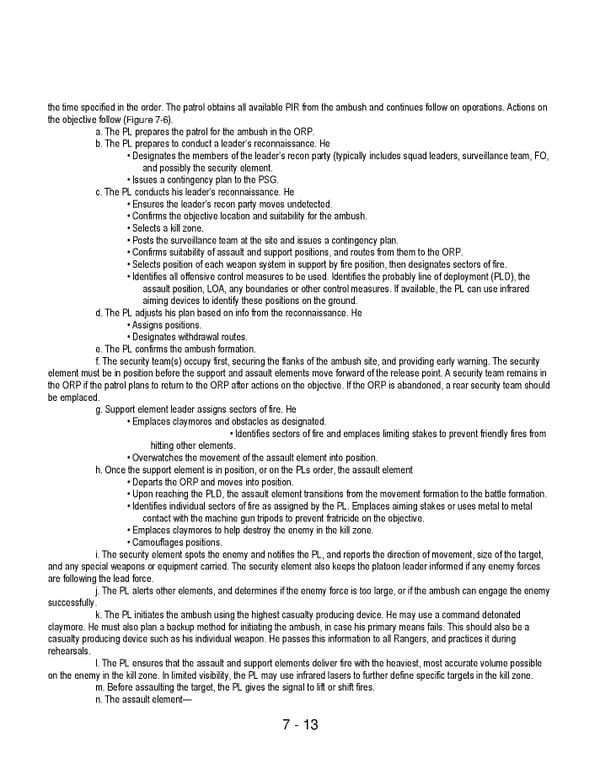7 - 13 the time specified in the order. The patrol obtains all available PIR from the ambush and continues follow on operations. Actions on the objective follow (Figure 7-6). a. The PL prepares the patrol for the ambush in the ORP. b. The PL prepares to conduct a leader’s reconnaissance. He • Designates the members of the leader’s recon party (typically includes squad leaders, surveillance team, FO, and possibly the security element. • Issues a contingency plan to the PSG. c. The PL conducts his leader’s reconnaissance. He • Ensures the leader’s recon party moves undetected. • Confirms the objective location and suitability for the ambush. • Selects a kill zone. • Posts the surveillance team at the site and issues a contingency plan. • Confirms suitability of assault and support positions, and routes from them to the ORP. • Selects position of each weapon system in support by fire position, then designates sectors of fire. • Identifies all offensive control measures to be used. Identifies the probably line of deployment (PLD), the assault position, LOA, any boundaries or other control measures. If available, the PL can use infrared aiming devices to identify these positions on the ground. d. The PL adjusts his plan based on info from the reconnaissance. He • Assigns positions. • Designates withdrawal routes. e. The PL confirms the ambush formation. f. The security team(s) occupy first, securing the flanks of the ambush site, and providing early warning. The security element must be in position before the support and assault elements move forward of the release point. A security team remains in the ORP if the patrol plans to return to the ORP after actions on the objective. If the ORP is abandoned, a rear security team should be emplaced. g. Support element leader assigns sectors of fire. He • Emplaces claymores and obstacles as designated. • Identifies sectors of fire and emplaces limiting stakes to prevent friendly fires from hitting other elements. • Overwatches the movement of the assault element into position. h. Once the support element is in position, or on the PLs order, the assault element • Departs the ORP and moves into position. • Upon reaching the PLD, the assault element transitions from the movement formation to the battle formation. • Identifies individual sectors of fire as assigned by the PL. Emplaces aiming stakes or uses metal to metal contact with the machine gun tripods to prevent fratricide on the objective. • Emplaces claymores to help destroy the enemy in the kill zone. • Camouflages positions. i. The security element spots the enemy and notifies the PL, and reports the direction of movement, size of the target, and any special weapons or equipment carried. The security element also keeps the platoon leader informed if any enemy forces are following the lead force. j. The PL alerts other elements, and determines if the enemy force is too large, or if the ambush can engage the enemy successfully. k. The PL initiates the ambush using the highest casualty producing device. He may use a command detonated claymore. He must also plan a backup method for initiating the ambush, in case his primary means fails. This should also be a casualty producing device such as his individual weapon. He passes this information to all Rangers, and practices it during rehearsals. l. The PL ensures that the assault and support elements deliver fire with the heaviest, most accurate volume possible on the enemy in the kill zone. In limited visibility, the PL may use infrared lasers to further define specific targets in the kill zone. m. Before assaulting the target, the PL gives the signal to lift or shift fires. n. The assault element—
 Ranger Handbook Page 124 Page 126
Ranger Handbook Page 124 Page 126